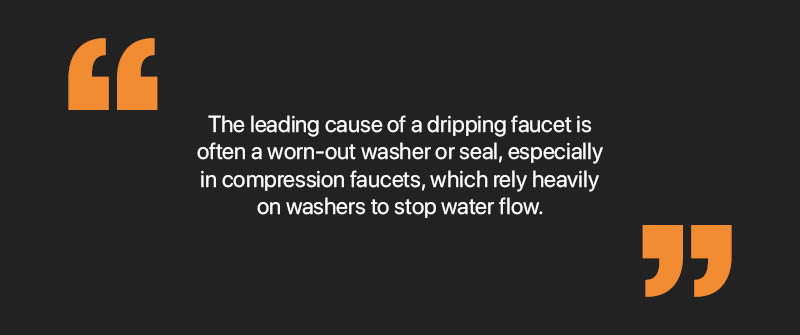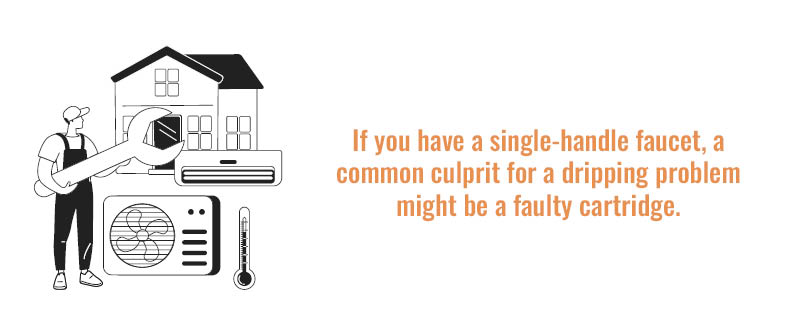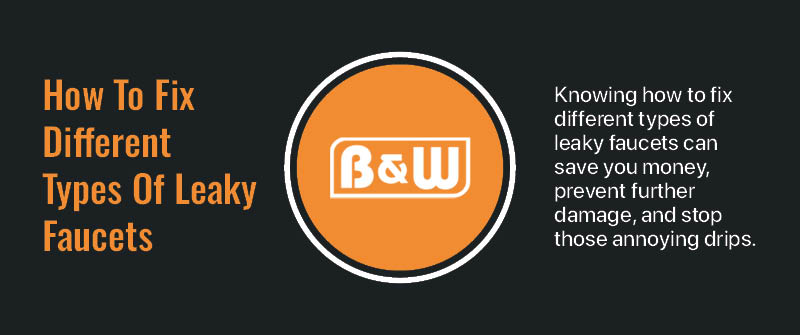What Causes A Faucet To Drip?
What Is The Most Common Cause Of A Dripping Faucet?
A dripping faucet can be a nuisance in your home, and one of the most common causes of this issue is a worn-out washer or seal. Over time, as these components experience repeated use, they begin to degrade and may no longer provide a tight seal, leading to persistent drips. Professional plumbing services can quickly identify and fix the issue, helping you address the root cause early, maintain your faucet’s efficiency, and conserve water.
What Causes a Faucet to Drip? The Role of a Worn-Out Washer or Seal
The leading cause of a dripping faucet is often a worn-out washer or seal, especially in compression faucets, which rely heavily on washers to stop water flow. Additionally, inspecting the valve body for mineral buildup is crucial, as issues with the valve body can contribute to leaks and other faucet problems. Each time the faucet is used, these washers are compressed, and constant friction may eventually cause them to wear out, resulting in leaks.
Corroded Valve Seat
A corroded valve seat can also lead to a dripping faucet. The valve seat is the connection between the faucet and the spout. If the valve seat becomes corroded due to water sediments, it can lead to leaks around the spout area.
Additionally, keeping the drain open is crucial to prevent water waste from a dripping faucet.
Loose Parts Or Worn-Out O-Rings
Faucets consist of numerous small components, including O-rings and gaskets, which can become loose or wear out over time. Any degradation in these parts can cause water to seep through and lead to continuous dripping. These leaks can result in the loss of several gallons of water each day.
Improper Installation Or Worn Components
In some cases, a dripping faucet can result from improper initial installation or the aging of faucet components. Even well-installed systems may face part wear, requiring attentive maintenance and prompt repair to prevent dripping issues. If the issue persists, it might be wise to call a plumber for professional assistance.
Why Does A Faucet Still Drip When The Water Is Turned Off?
Even when the water is turned off, a faucet can persistently drip due to several underlying issues, ranging from a simple worn-out washer to more complex problems like high water pressure or a faulty cartridge. This can cause worry for homeowners, as a slow drip may not pose an immediate flooding threat but can lead to water waste and escalate into more significant issues if left unattended. Addressing these problems promptly can help you avoid larger issues down the line, such as increased water bills and potential water damage.
Damaged Washer Not Sealing Properly
One of the most typical reasons a faucet still drips is a damaged or worn-out washer that’s not providing a proper seal. Over time, the constant friction between the washer and the valve seat can cause wear and tear, preventing it from sealing effectively when the faucet is turned off. This usually results in a slow, steady drip that can be quite frustrating if left unchecked, and if ignored, bigger problems can happen over time.
High Water Pressure Causing Leaks
High water pressure is another common cause of a dripping faucet. When the pressure is too high, water might find its way through small leaks even when the tap is turned off. Apart from causing faucets to drip, excessive pressure can lead to other plumbing issues and even damage to your home’s pipes, so it’s essential to maintain appropriate levels. High water pressure can also affect the flow of water, causing stress on components like cartridges and washers, which can lead to leaks.
Mineral Deposits Affecting Water Flow
In areas with hard water, mineral deposits can build up and affect the proper closing of your faucet. Deposits such as lime and calcium can clog the faucet parts, making it difficult to shut off the water completely. These minerals can harden over time, making it increasingly challenging to stop the leak without intervention. Homeowners should notice signs of mineral buildup, such as reduced water flow or difficulty in shutting off the faucet.
Faulty Cartridge In A Single-Handle Faucet
If you have a single-handle faucet, a common culprit for a dripping problem might be a faulty cartridge. The cartridge is responsible for regulating water flow and temperature, and any malfunction can lead to continual dripping. Replacing a defective cartridge can often resolve the issue effectively. A faulty cartridge can prevent a watertight seal, leading to leaks.
Understanding the various elements that could contribute to a faucet still dripping even after it’s turned off can aid in performing troubleshooting and ensuring a quick, effective fix. Sometimes, a simple DIY repair can suffice, while in other cases, professional assistance may be necessary to address the root cause and maintain the longevity and efficiency of your plumbing system.
How Do I Stop My Faucet From Dripping?
Stopping your faucet from dripping not only helps in reducing water wastage but also saves you from pesky sounds and potential water bills. The good news is that most dripping faucets can be fixed with a few easy steps, whether it’s due to worn washers, faulty cartridges, or high water pressure. Devoting a little time to identifying and correcting the problem can save you money and conserve water.
Replace Worn Washers Or Seals
The first step to stopping a persistent faucet drip is to check the washers and seals. Over time, these components can wear out and fail to properly seal the water flow when the faucet is turned off. To fix this, turn off the water supply, disassemble the faucet, and replace any worn washers or seals. Ensure you have a matching replacement to avoid further issues. Replacing worn washers or seals can significantly reduce water waste.
Check And Replace O-Rings
O-rings are small but critical components in preventing leaks. Over time, these can wear out, especially if they’re constantly exposed to water and friction due to repeated usage. Inspect the O-rings for wear and tear, and replace them if they appear worn. This simple fix can often resolve drips that occur at the handle or spout base. Broken O-rings can lead to leaks and should be replaced promptly.
Adjust Or Lower Water Pressure
High water pressure can sometimes contribute to persistent drips or leaks as it forces water through even the smallest of gaps. Test your home’s water pressure to ensure it’s not excessively high. Adjust it if necessary by regulating the main pressure valve or investing in a pressure regulator to maintain a balanced flow. High water pressure can also cause leaking, so it should be adjusted to prevent this issue.
Replace Faulty Cartridges
In single-handle faucets, a faulty cartridge is often the culprit behind a consistent drip. Cartridges manage the mix of hot and cold water and control the water flow. When they become damaged or worn, they can cause leaks. To fix this, purchase a replacement cartridge specific to your faucet model and follow the manufacturer’s instructions for installation. Additionally, it is crucial to inspect all the parts of the faucet, including rubber washers, O-rings, and seals, to ensure there are no other issues contributing to the leak.
Tighten Loose Parts
Sometimes, the fix is as simple as tightening a loose part. Check to see if any of the components, such as the handle, nut, or spout, are loose. Carefully tighten them with a wrench or screwdriver while ensuring not to overtighten and cause damage. A snug fit is crucial to maintaining a drip-free faucet. Tightening loose parts can also prevent wasted water from leaks.
If you’ve tried these fixes and the dripping persists, it might be time to consider calling in a professional. At B&W Heating, Cooling, Plumbing and Electric, our skilled plumbers can quickly identify and rectify more complex plumbing issues, ensuring your faucet returns to optimal performance.
How To Fix Different Types Of Leaky Faucets
Knowing how to fix different types of leaky faucets can save you money, prevent further damage, and stop those annoying drips. Whether it’s a single-handle or a double-handle faucet, understanding the specific repair methods can make all the difference. Let’s dive into the details of fixing different types of faucets and ensuring they work efficiently. A damaged cartridge is a common issue in cartridge faucets and should be replaced to stop leaks.
How To Fix A Leaky Faucet Single Handle?
Fixing a single-handle faucet often involves replacing the cartridge that’s responsible for controlling both water flow and temperature. First, turn off the water supply and remove the faucet handle by loosening the screw beneath the cap. Once the handle is off, remove the cartridge nut using a wrench. Replace the old cartridge with a new one, ensuring it’s positioned correctly, then reassemble the faucet.
Remember to turn the water supply back on gradually to check for leaks. If the dripping persists, ensure the replacement cartridge is compatible with your faucet model or consult a professional for assistance. Newer faucets often have improved designs that can prevent common issues like leaks.
Guide To Fixing Double-Handle Faucets
Double-handle faucets control hot and cold water separately and generally involve replacing a washer or seat. First, turn off the water supply and remove the faucet handles by unscrewing them. Use a wrench to extract the valve stem or cartridge. Check the washer that’s seated at the bottom for wear or damage and replace it if necessary. Reinstall the valve stem, ensuring it’s tightly fitted, and replace the handles.
After reassembly, slowly turn the water back on to check for leaks. If the faucet continues to leak, the valve seat might be corroded and need replacing. This is often best performed by a professional to ensure a precise fit and function. Worn or damaged components like washers, O-rings, and seals should be replaced to ensure proper faucet function.
Tools Required For Faucet Repair
Tackling faucet repair requires some basic tools: a screwdriver, an adjustable wrench, Allen wrenches, and replacement parts like O-rings or cartridges. Having a basin wrench can also be helpful for hard-to-reach spots under the sink. Always ensure the tools are the correct size and type to avoid causing further damage to your fixtures. There are a few reasons why a faucet might leak, such as worn washers or high water pressure.
When To Call A Professional
If you’ve tried the steps above and your faucet still drips, it might be time to call in a pro. Persistent leaks could be a sign of more complex issues, such as deep-seated corrosion or plumbing problems that require specialized knowledge. A professional ensures the job is done right, preventing potential water damage or higher bills. They can also help identify and fix issues with the controls of the faucet, such as cartridges and diverters.
B&W Heating, Cooling, Plumbing and Electric offers reliable, expert services for all your plumbing needs. Book an appointment and learn more about our accessible pricing, fast response times, and expert repairs to keep your home running smoothly without hidden fees.



